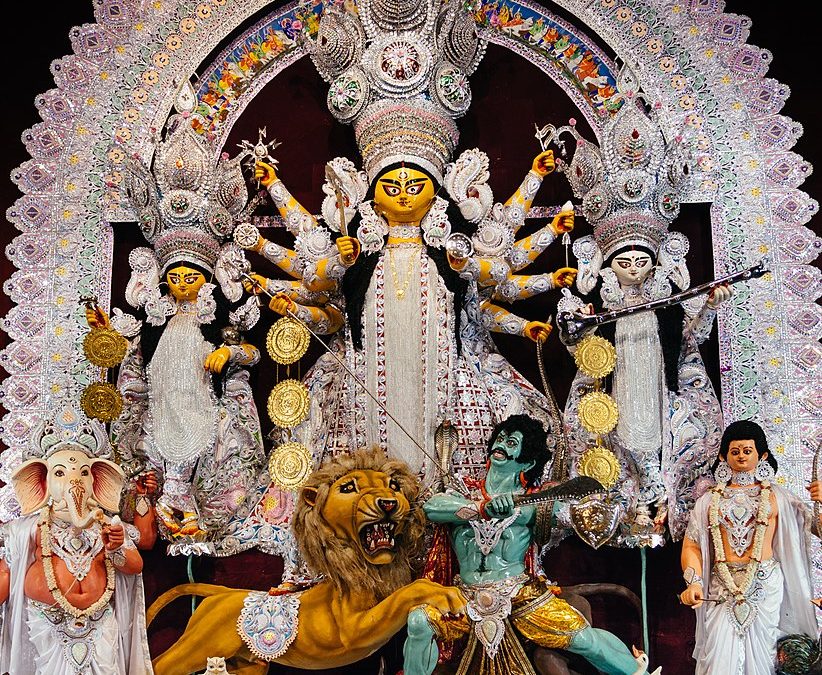The season of Durga Pooja is going to come! The puja, one of the most prominent festivals in India, especially in West Bengal, is a grand celebration of the victory of good over evil. It marks the worship of Goddess Durga, who is revered as the embodiment of Shakti (power) and is celebrated with immense devotion, vibrant rituals, and artistic splendor. The festival typically spans ten days, culminating in the final five days, known as Shashthi, Saptami, Ashtami, Navami, and Vijayadashami. Each day has its unique significance and rituals.
Day-Wise Pooja Details
1. Mahalaya
Although not part of the main five days, Mahalaya marks the beginning of Durga Puja. On this day, devotees invoke the Goddess and request her to descend on Earth. It is also a day of paying homage to ancestors through the ritual of Tarpan. The chanting of the sacred verses from the Mahishasura Mardini marks the official countdown to the festivities.
2. Shashthi (Sixth Day)
– Bodhon: The main festivities begin on Shashthi with the Bodhon ceremony, which is the unveiling of the face of the idol. This ritual signifies the awakening of the goddess.
– Amantran and Adhivas: These are the rituals of inviting the goddess and sanctifying the area where she will reside during the puja.
3. Saptami (Seventh Day)
– Nabapatrika Puja: On this day, nine different plants, symbolizing the nine forms of Goddess Durga, are worshipped. The Nabapatrika is bathed in the holy water of the Ganges and is draped in a sari before being placed beside the idol of Durga.
– Kalparambha and Pran Pratishtha: These rituals involve the installation of the idol and the life force being invoked in the idol through chants and mantras.
4. Ashtami (Eighth Day)
– Sandhi Puja: This is one of the most significant rituals of Durga Puja, performed during the last 24 minutes of Ashtami and the first 24 minutes of Navami. It is believed that during this time, Goddess Durga killed the demon Mahishasura, symbolizing the victory of good over evil.
– Kumari Puja: Young girls, representing the goddess, are worshipped and offered new clothes and sweets as part of this ritual.
– Pushpanjali and Aarti: Devotees offer flowers to the goddess during the chanting of mantras, followed by the evening aarti.
5. Navami (Ninth Day)
– Maha Navami Puja: This day involves the final set of rituals before the departure of the goddess. The day is marked by chanting prayers and mantras, followed by offerings of bhog (food offerings).
– Maha Aarti: The grand aarti marks the conclusion of the puja rituals. It is a moment of high devotion and emotion as devotees gather to seek the blessings of the goddess.
6. Vijayadashami (Tenth Day)
– Sindoor Khela: Married women apply sindoor (vermilion) to the goddess and to each other, symbolizing the strength and unity of womanhood.
– Visarjan (Immersion): The festival concludes with the immersion of the idols in rivers or water bodies. It symbolizes the departure of the goddess to her celestial abode, with a promise to return the following year. Devotees bid farewell with chants of “Bolo Durga Mai Ki Jai” and “Asche Bochor Abar Hobe” (She will return next year).
The Essence of Durga Puja
Durga Puja is a cultural illusion as well as a religious occasion. People from all walks of life join together to revel, create, and celebrate the spirit of community. The vibrant pandals (temporary structures housing the idols), artistic decorations, traditional music, dance, and food add to the charm of this festival.
Each day of Durga Puja represents a unique blend of devotion, art, and culture, making it one of the most anticipated and celebrated festivals in India. As the festival comes to an end on Vijayadashami, it leaves behind memories of joy and anticipation for the goddess’s return next year.




